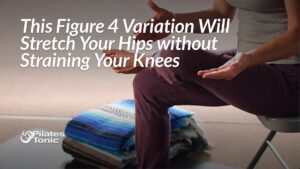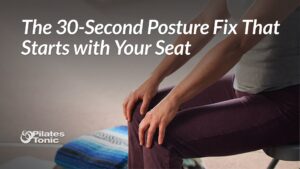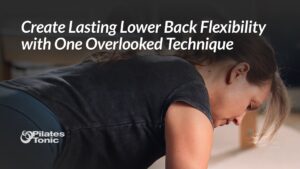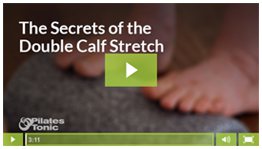Unconscious quadriceps tension keeps your thighs tight and your kneecaps chronically lifted.
This chronic kneecap tension might not seem like a big deal, but when it comes to pain-free knee joints that last a lifetime, this seemingly minor problem is a major player.
It sounds pretty simple to just relax your kneecaps, but if quad tension has become an unconscious habit for you, or if you've been unknowingly using your quads to keep yourself from falling over when you stand, relaxing the knees may not be an easy task.
You have four quadricep muscles that are designed to activate equally and at the same time when you straighten your lower leg, but in our culture we've acquired alignment faults that leave the femur bone internally rotated and our pelvis misaligned. This changes the ability of the quadriceps to activate properly.
When the pelvis is misaligned, it changes your body's ability to recruit the appropriate muscles for walking and standing, so your quads pick up the slack.
The quadriceps can get so used to staying on and being recruited for extra work that it becomes difficult to figure out how to turn them off, even when your brain is asking them too!
The exercise in today's video comes from Katy Bowman's Restorative Exercise™ Institute and it shows you a deceptively simple way to relax your quads.
I'll be exploring the alignment faults that lead to chronic quad tension in future posts, but for now have fun seeing if you can relax your kneecaps!
See you in the studio!
Sydney
P.S. – If you still find it difficult to relax your kneecaps with the wall, try sitting in a chair and, without lifting your heels, slowly sliding your legs out straight. Then see if you can relax your kneecaps in this seated position.





26 Responses
Why is it bad to pul your knee caps up? Doesn’t this help to not hyperextend the knees,
Hi Marcia, It’s not so much the pulling up of the kneecaps themselves that’s the issue, it’s constantly holding them up. For a lot of people it’s become a mechanical habit that they can’t release even when their brain is asking them too. With hyperextended knees there’s often an internal rotation of the femurs. Correcting this internal rotation of the femurs and balancing the activation of the quadriceps is huge when it comes to helping hyperextended knees, but learning how to relax the kneecaps has to come first. Thanks for your question!
Love keeping in touch with you and your studio. You are an inspiration! Thanks for the good stuff!!
Thanks Allyson! It’s always great to hear from you. Hope you are doing well!!
Hi Sydney– I just found your website and videos and am very impressed with your information and presentations! So far I haven’t found one that specifically addresses my “issue”, so maybe you can point me in the right direction. After sitting for more than a few minutes -especially if I am sitting curled up on the couch reading- I find it difficult to stand up and immediately start walking. Not sure if it is a weakness in my quads or what, but there is kind of a dull pain and it takes a few seconds for me to get going at a normal pace and without pain. I do a lot of water running with flotation cuffs so I am wondering if I am working my hammies and glutes too much more that the quads? Or is one or the other too tight? I’m not sure what is really going on, so thought I’d see if you have an exercise or stretch to recommend. I did Pilates Mat for several years, but the class I was taking is no longer available so I am wondering if stopping that has been detrimental as I don’t recall having this problem when I was doing the Mat routines. Any advice you have to offer would be much appreciated!
Hi Alice, I can’t say specifically what’s causing your experience. That said, varying your movement more could help. Especially, when sitting or curled up on the couch for more than a few minutes. Simply adjusting your position by straightening out your legs for a few minutes and stretching your arms overhead could go a long way. Here’s a link to a free Hip Flexor focused workshop you might also find helpful. Thanks so much for your feedback and question!
Hi Sdyney
Please tell me why and what toe strap you are wearing ? I have foot problems and wondering if they will help me to walk around easier barefooted. Love your videos thank you
Hi Anna, I’m wearing Correct Toes. They are awesome! Thanks for your question.
Oh my, Sydney. When I leaned on the wall and gave my left kneecap a little downward pressure–oh the relief. I had no idea I wasn’t dropping them. I could see them drop a little–but not like in your first video. That was a pressure drop. If your knees were barometers, it would be raining now! S
Lol and wow, Susan that is awesome! So glad you tried the exercise. Thanks for your feedback!
Thanks a lot for this! This sounds exactly like my situation. Can this also present as pain when descending in the squat because you tense up in the quads? Same thing with cycling. And should you tense “differently” when doing these activities? Or will the pain go away when you learn to relax the quads? I hope that last part makes sense 🙂
Hi Thomas, great questions! Chronic quad tension keeps the kneecaps lifted, preventing the patella (kneecap) from tracking in its natural groove. So when you bend your knees for a squat, or cycle and your patella isn’t tracking in its groove, it gets pulled into soft tissue instead and this can hurt (especially if that soft tissue is already inflamed or swollen). Relaxing your kneecaps will help tremendously, combined with stretching your quads.
Here’s a link to my favorite quad stretch:
https://pilatestonic.com/2015/got-quads-youll-love-this-quad-stretch/
Hope this helps and thanks for your questions!
What is the reason behind this ? Since I started noticing, I found that my right knee cap remains lifted, only after I am aware of it then it becomes relaxed. What causes this, I am a person with health anxiety and I am worried a lot about different other conditions. Is it normal ? Can this be corrected ?
Hi Sampat, First off, it’s fantastic that you can lower your right kneecap after noticing it’s still lifted! That’s a really great sign and should definitely ease your mind. The reason behind lifted kneecaps is chronic tension in the quadriceps–generally stemming from standing with weight more forward in the feet. Here are a couple of videos that go into a bit more detail:
https://pilatestonic.com/2020/your-glutes-were-made-for-walking/
https://www.pilatestoniconline.com/courses/how-to-drop-your-kneecaps/329162-default-section/938381-how-to-drop-your-kneecaps
I hope this helps, and thanks for your questions!
Thanks a lot, Ma’am Sydney. Now I really feel a little less anxious about this and a lot relieved, now I can continue practicing the exercise and get back to normal. Thanks a lot for the advice. And I am professional Basketball player, I thought I had muscle strain which led into this.
Hi Sydney, both my knees are sore since my open compound fracture and re-learning how to walk again. My gait is all messed up which I know is contributing to it. Are their any exercises or stretches that would assist me in getting my knees back into proper rotation and relaxation so they don’t feel like they are going to collapse on me? Thanks!
Hi Sylvia, thanks for your question! Without seeing you and knowing more about your injury, it’s hard to be specific, but here are some more general exercises that might be helpful. Make sure to check with your medical provider first.
Quad Stretch
https://pilatestonic.com/2015/got-quads-youll-love-this-quad-stretch/#comments
Hip Flexor Stretch
https://pilatestonic.com/2021/special-preview-your-glutes-are-connected-to-your-hip-flexors/
This video has a series of exercises to benefit walking:
https://pilatestonic.com/2020/your-glutes-were-made-for-walking/
This one is a bit of stretch and strength:
https://pilatestonic.com/2021/special-preview-the-sneaky-simple-way-to-build-strength/
I hope these help, and wishing you all the best!
Hi, after watching this video and Rolfing for about a month, I was able to “drop” or relax my knees for the first time. Now I’m obsessed! It’s such a wild sensation, but also very relieving. Is it normal to feel like the part of the knee below the knee caps is tender? Will this strength over time if I continue to relax my knees? Will it help shrink my quads and stop them from being the dominant muscle? Thanks for your help.
Wow, that’s great, Kay! Congrats on dropping your kneecaps— it’s a big deal! How you stand and the shoes you wear make all the difference when it comes to developing the strength and balance in your body for the kneecaps to stay down. The video linked below goes into more detail about standing alignment:
https://pilatestonic.com/2020/were-getting-the-band-back-together-and-reshaping-your-booty/
This is a longer video with even more details:
https://pilatestonic.com/2020/your-glutes-were-made-for-walking/
And this one might be helpful for the discomfort below the knee:
https://pilatestonic.com/2021/your-shin-bones-connected-to-your-lower-leg-discomfort/
Hope this helps and thanks for your questions!
The standing video is exactly the next step I’m trying to do! I am so quad dominant and have been for so long that shifting my weight back throws me off balance quite a bit.
Hi Sydney. I am still struggling to understand exactly how to release the knee caps and then lift and lower them at my own free will. I would appreciate any further instructions you might have. Thanks in anticipation. Alex 🙏
Hi, Alex! Dropping the kneecaps is a process, for sure, especially if your quadricep muscles are used to holding your kneecaps up all of the time. Stretching the quads helps to release some of the tension, and paying attention to how you stand helps too. The video linked below goes into more detail on standing alignment:
https://www.pilatestonic.com/2020/were-getting-the-band-back-together-and-reshaping-your-booty/
I go into a lot much more detail around this process inside of the PTO membership. Here’s a link in case you want to check it out:
https://pto.pilatestonic.com/
Thanks for your question!
Hi Sydney
I came across your website when looking for knee release exercises. Thank you so much for your very clear and helpful explanation. As a result, I have now come to realise that the root cause of my chronic kneecap lifting is taking my standing weight too far back into my heels. I had a question: I’ve noticed that when I release the knee caps, not only does the tension fall from the front of my thighs but also from my low abdomen (belly and pelvis) and glutes area which seems also to release and “open” more fully. This is a big change for me compared to my usual posture. I wondered if you experience similar and if this sounds or if – for example – it indicates I’m being sloppy with my core. Thank you!
Hi, HKS, It sounds like you’re releasing unnecessary tension in your abdomen and glutes, in addition to the thighs, which is fantastic and not sloppy with your core at all. Thanks for your feedback and question!
Hi Sydney, I just wanted to follow up to say I have been continuing to practice this and it has made a significant difference. It’s amazing how much unnecessary tension I was holding. Thank you so much. (Now it’s summer, I’m also noticing raised kneecaps everywhere I look!)
Hi Hardeep! Thanks for following up. I’m thrilled releasing your kneecaps has continued to help and I know what you mean about seeing it everywhere. Once you’re aware of it, it’s hard to unsee! 😆 Happy summer to you!